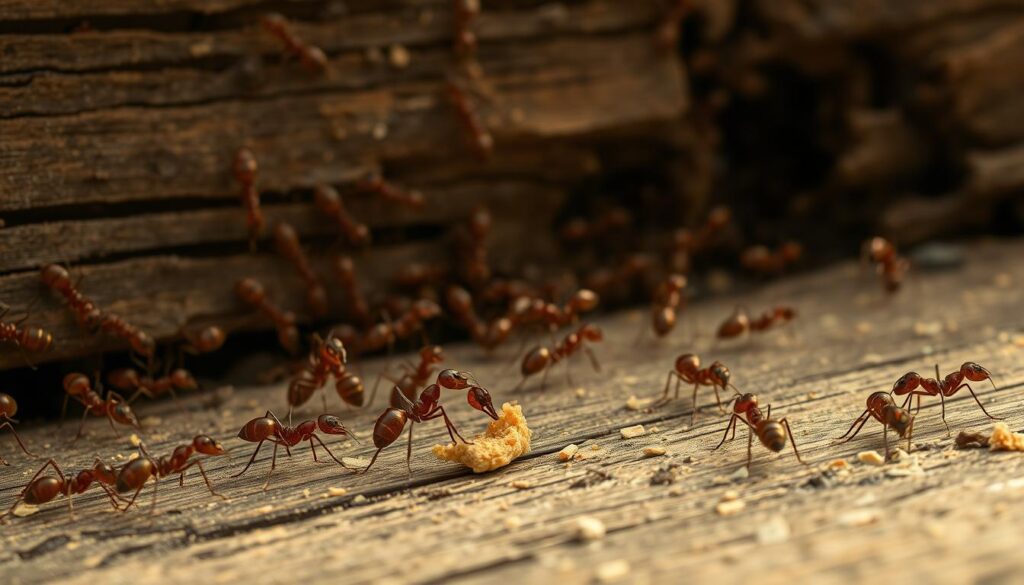Virginia’s climate and ecosystems support many ant species. Knowing about types of ants in virginia is key for homeowners. These small insects play big roles in nature but can also be a problem.
They can cause damage to buildings and hurt people with their bites. Fire ants, for example, are invasive. Their stings can cause red welts. This shows why knowing what ants you have is important.
Key Takeaways
- This guide covers eight common ant species in Virginia.
- Ants impact both natural habitats and human environments.
- Identifying species helps prevent property damage and health risks.
- Some ants, like carpenter ants, weaken wooden structures.
- Understanding behaviors aids in effective pest management.
Introduction to Ants in Virginia
Virginia’s ecosystems rely on its 250+ ant species. They shape environments from forests to backyards. These tiny insects aerate soil, recycle nutrients, and support plant life.
While most species are harmless, some threaten homes or pets. Understanding their roles helps balance coexistence with these vital but sometimes troublesome creatures.
Importance of Ants in the Ecosystem
Ants improve soil health by digging tunnels. These tunnels let oxygen and water reach plant roots. They break down decaying matter, turning leaves and waste into nutrients plants can use.
Some species spread seeds, aiding forest regeneration. Their colonies also feed birds and small animals. This links them tightly to food webs.
Overview of Ant Diversity in Virginia
Virginia ant species range from the 1/16-inch thief ant to the ½-inch carpenter ant. Forests, gardens, and urban areas host types like pavement ants, fire ants, and odorous house ants. Each species has unique nesting habits—from soil mounds to tree cavities.
This diversity means some aid nature while others invade homes. Awareness is key to managing their impacts.
Carpenter Ants: The Wood-Destroyers
Carpenter ants are very harmful common ants in Virginia. They nest in wooden parts of homes. They don’t eat wood but make tunnels that weaken it.
Identification Characteristics
Adult carpenter ants can grow up to ½ inch long. They are Virginia’s biggest common ants. They have shiny black bodies, heart-shaped heads, and six legs.
Their big mandibles help them chew wood. This leaves smooth tunnels in walls or attics.
Common Habitats
These ants like moist places. They nest in rotting trees, decaying stumps, and damp wood. They like:
- Leaky roofs or window sills
- Rotting porches or decks
- Behind bathroom tiles or under sinks
Impact on Homes and Structures
Damage starts small but gets worse. Signs include:
- Fine sawdust piles near walls
- Rustling noises in walls at night
- Frail support beams
Infestations start outside and move inside. Check crawl spaces and basements often to find colonies early.
Fire Ants: The Aggressive Invaders
When you look at identifying ants in Virginia, fire ants are easy to spot. They are aggressive and have unique features. Experts say their painful stings and hidden nests are a big worry.
What Makes Them Unique
Fire ants are reddish-brown and have a special stinger. They attack in groups, causing painful bites. People in Virginia often find out they have a problem after getting bitten.
- Key traits: Aggressive swarming behavior
- Sting symptoms: Painful welts requiring medical attention
- Coloration: Copper heads and darker abdomens
Location and Nesting Habits
Spotting identifying ants in virginia means looking for their hidden mounds. Their nests look like flat patches in sunny spots. Unlike carpenter ants, fire ants build underground tunnels with many entrances.
USDA studies show 45% of Virginia’s outdoor spaces have fire ant colonies. It’s important to get a professional to check for hidden tunnels. Look for signs in moist soil near buildings during spring and summer.
Pavement Ants: The Urban Dwellers
Pavement ants are common in Virginia’s cities. They live where concrete meets the outdoors. They build homes under sidewalks, driveways, and buildings.
Physical Features
These ants are small and have unique markings:
- Dark brown or black bodies, 2-3 mm long
- Ridges on their backs and spines
- Pale legs and antennae divided into 12 segments
Their narrow shape helps them fit into pavement cracks. This makes them well-suited for city life.
Social Structure and Behavior
Pavement ants live in big groups with many queens. Worker ants follow straight paths to find food. They often fight with other ants for food.
- Nests expand under sidewalks, creating visible soil piles
- Forage at night, following scent trails
- Compete fiercely with other ants for food resources
People often see them near food spills or pavement cracks. Their ability to adapt makes them a big problem in Virginia’s cities.
Thief Ants: The Sneaky Scavengers
Thief Ants in Virginia are experts at hiding. They sneak into homes without being seen. They leave behind tiny trails of crumbs and confusion.
Their small size and secret ways make it hard to catch them early. It’s important to spot them before they cause more trouble.

Identification Tips
- Size: 1/16-inch long—smaller than most common ants
- Pale yellow-brown bodies with thin waists
- Trail behavior: follow paths leading to food sources like pantries or kitchens
Preferences for Nesting Sites
Thief Ants like to hide in safe places:
- Wall voids and insulation gaps
- Behind appliances or baseboards
- Under debris in gardens or near foundations
Look for tiny trails near where you store food. Their nests can grow fast. So, act quickly if you see any signs.
Clean up crumbs and seal food well. This will help stop their sneaky ways.
Odorous House Ants: The Smelly Houseguests
These tiny ants may be small, but their presence is hard to miss. When crushed, they release a sharp, distinctive odor. This smell is often compared to rotten coconut. Spotting them early helps stop infestations before they spread.
How to Recognize Them
Look for these clues:
- Size: 2.4mm long, dark brown to black bodies
- Trail patterns: March in orderly lines along baseboards and counters
- Smell test: Crush one to confirm the pungent coconut-like scent
Nesting Locations
They thrive in damp, hidden spots like:
- Behind kitchen cabinets
- Under bathroom sinks
- Inside wall voids near plumbing leaks
- Near pet food bowls
Controlling moisture buildup and sealing food sources can deter these sneaky invaders. Early detection stops them from multiplying quickly.
Sugar Ants: Sweet Tooth Scouts
Sugar ants are known for their love of sweet things. They are small, with dark brown or black bodies and long antennae. They move in straight lines, leaving trails to find food.
Appearance and Behavior
Sugar ants use pheromones to tell each other where food is. Their trails can go from nests in walls to food in the house. Spotting these trails helps find an infestation.
They don’t like to fight. Instead, they quietly look for food.
Attraction to Food Sources
These ants love sugars, syrups, and spilled drinks. They’ll go into open containers or crumbs on counters. To keep them away:
- Store food in airtight containers
- Wipe down surfaces daily
- Seal cracks near foundations
Knowing how they behave helps keep them out. Quick action stops colonies from growing. This protects homes from big infestations.
Big-Headed Ants: The Unusual Foragers
Virginia is home to many ants, including the big-headed ant. They are known for their big heads. These heads help them survive.
Identifying Features
Adult workers of these ants vary a lot in size. The big ones have huge heads, while the small ones have smaller heads. They are 1.5 to 3 mm long and can be light or dark brown.
Their big heads help them crack seeds and move things around.
Activity and Diet
These ants move in straight lines between their homes and food. They like to be near mulch or stone piles. They eat a mix of protein and carbs.
- Insects and insect larvae
- Nectar and honeydew
- Processed sugars
They also farm mealybugs and scale insects for their sweet secretions. This creates a special relationship between them.
Control tip: Look for soil piles near their nests. They dig tunnels while they forage.
Tips for Dealing with Ant Problems
“Early detection and proactive measures are the first steps in managing invasive ants in Virginia,” says the Virginia Department of Agriculture.
Keeping homes safe from invasive ants in Virginia is easy. Simple steps can stop ants from growing and protect families. Here’s how to act before and during an infestation.
Prevention Strategies
Here are ways to keep ants away:
- Seal cracks, windows, and doors with caulk or weatherstripping.
- Keep kitchens tidy: store food in airtight containers and wipe counters daily.
- Fix leaks and improve drainage to cut moisture sources ants rely on.
- Trim bushes and trees away from walls to block outdoor pathways.
Safe Removal Methods
When ants invade, choose safe methods:
- Place bait stations near trails. Ants carry poison back to nests, eliminating colonies slowly.
- Use natural options like vinegar sprays or diatomaceous earth in hard-to-reach areas.
- Avoid spraying general pesticides indoors—this can scatter colonies instead of eradicating them.
- Contact licensed pest control if nests are large or in sensitive areas like walls.
Act quickly but carefully. Mistakes like spraying repellents only disperse ants, worsening infestations. Always read product labels and prioritize child/pet safety.
Conclusion: Understanding Virginia’s Ant Population
Virginia’s landscapes are home to many ant species. Each has its own traits and plays a role in the environment. Knowing about these ants helps protect homes while also respecting nature.
Recap of Common Ant Species
Carpenter ants damage wood, while fire ants sting hard. Pavement ants make nests near walkways. Odorous house ants smell bad when stepped on.
Sugar ants love sweet foods. Thief ants follow food trails. Big-headed ants forage openly. Each needs its own way to be managed.
Importance of Ant Awareness
Spotting ants early stops big problems. Knowing about ants lets homeowners take action. This can be sealing holes or getting help from pest control experts in Virginia.
It’s all about finding a balance. Small steps like cleaning up crumbs or checking for moisture help a lot. This way, we can live with ants safely and without harming them.


















